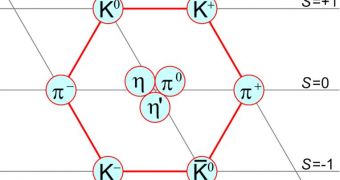Researchers at the University of Glasgow believe that the Bc meson, one of the newest types of hypothesized elementary particles, may have already been unknowingly produced in particle accelerators such as the Tevatron, in Illinois. Facilities operated by CERN, including the Large Hadron Collider (LHC) and others, may have produced the particle, but experts browsing through the massive amount of data that results from collisions may have failed to discover signs of it. Now, the UG team managed to predict the Bc meson's mass through calculations, PhysOrg reports.
Understanding this meson could hold the key to also understanding the strong nuclear force, which is one of the basic forces in the Universe. It dictates the interactions between subatomic particles, and is also responsible for keeping quarks – the basic particles making up matter – glued together. Physicists at the UG Department of Physics and Astronomy's Particle Physics Theory Group conducted the new investigation, which relied on the use of advanced supercomputers to produce the necessary calculations. The group was led by quantum chromodynamics (QCD) theory expert, Professor Christine Davies.
“Although this meson has not yet been shown to exist, our calculations have allowed us to predict not only its existence but also its mass. Two previous predictions we've made have been shown to be true so we are confident with this one,” the researcher explains. She adds that mesons are in fact pairs of quarks, as the particles can never exist independently. Groups of three quarks are called baryons. Both mesons and baryons are collectively known as hadrons, which is precisely why the “H” exists in LHC.
“The HPQCD collaboration specializes in accurate calculations of the properties of the 'particle zoo' of mesons using the theory of the strong force (QCD), and uses these calculations to determine the properties of quarks. The calculations must be done on very powerful computers, because the strong force is so powerful that it leads to very complicated interactions,” Davies adds. The Bc meson is composed of two quarks, a bottom and a charm one, whose spin has the same orientation. There are six types of quarks, known as up, down, charm, strange, top and bottom.

 14 DAY TRIAL //
14 DAY TRIAL //